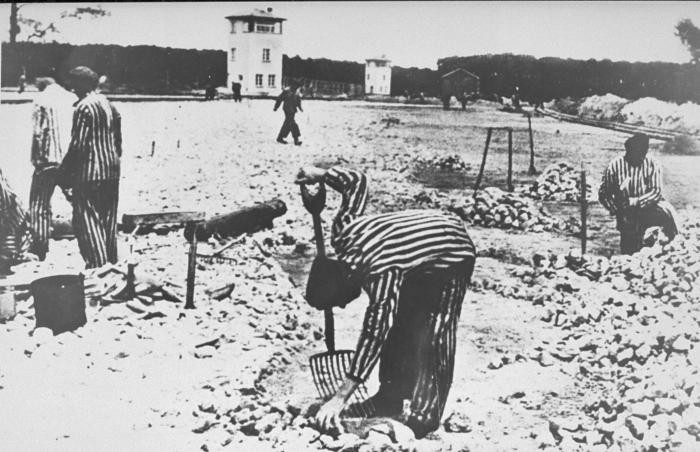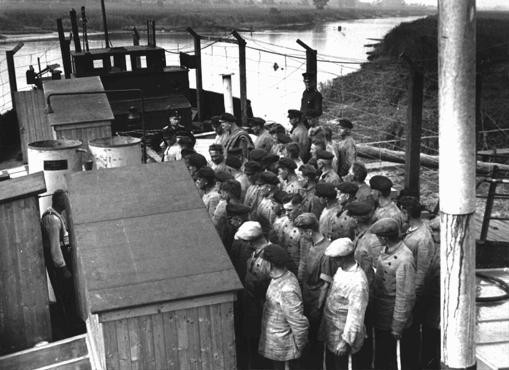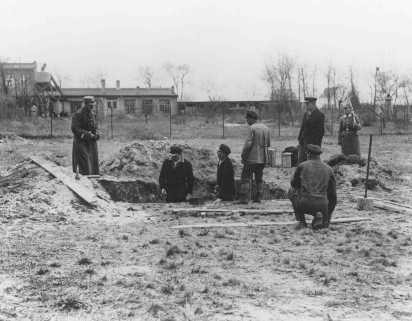
Concentration Camps, 1933–39
During the first six years of the Nazi regime, thousands of Germans were detained or confined extra-legally. The conditions were usually harsh and there was no regard to the legal norms of arrest and imprisonment of a constitutional democracy.
Key Facts
-
1
Nazi officials established the first concentration camp, Dachau, on March 22, 1933, for political prisoners. It was later used as a model for an expanded and centralized concentration camp system managed by the SS.
-
2
What distinguishes a concentration camp from a prison (in the modern sense) is that it functions outside of a judicial system. The prisoners are not indicted or convicted of any crime by judicial process.
-
3
The major purpose of the earliest concentration camps during the 1930s was to imprison and intimidate the leaders of political, social, and cultural movements that the Nazis perceived to be a threat to the survival of the regime.
Concentration camps (Konzentrationslager; abbreviated as KL or KZ) were an integral feature of the regime in Nazi Germany between 1933 and 1945.
The term concentration camp refers to a camp in which people are detained or confined, usually under harsh conditions and without regard to legal norms of arrest and imprisonment that are acceptable in a constitutional democracy.
The First Concentration Camps in Germany

The first concentration camps in Germany were established soon after Hitler's appointment as chancellor in January 1933. In the weeks after the Nazis came to power, the SA (Sturmabteilung; commonly known as the Storm Troopers), the SS (Schutzstaffel; Protection Squadrons—the elite guard of the Nazi party), the police, and local civilian authorities organized numerous detention camps to incarcerate real and perceived political opponents of Nazi policy.
German authorities established camps all over Germany on an ad hoc basis to handle the masses of people arrested as alleged subversives. The SS established larger camps in Oranienburg, north of Berlin; Esterwegen, near Hamburg; Dachau, northwest of Munich; and Lichtenburg, in Saxony. In Berlin itself, the Columbia Haus facility held prisoners under investigation by the Gestapo (the German secret state police) until 1936.
Centralization of the Concentration Camp System

The SS gained its independence from the SA in July 1934, in the wake of the Röhm purge. Hitler then authorized SS leader Heinrich Himmler to centralize the administration of the concentration camps and formalize them into a system. Himmler chose SS Lieutenant General Theodor Eicke for this task. Eicke had been the commandant of the SS concentration camp at Dachau since June 1933. Himmler appointed him Inspector of Concentration Camps, a new section of the SS subordinate to the SS Main Office.
After December 1934, the SS became the only agency authorized to establish and manage facilities that were formally called concentration camps. Local civilian authorities did continue to establish and manage forced-labor camps and detention camps throughout Germany. In 1937, only four concentration camps were left: Dachau, near Munich; Sachsenhausen near Berlin; Buchenwald near Weimar; and Lichtenburg near Merseburg in Saxony for female prisoners.
Purposes of the Camp System
Concentration camps are often inaccurately compared to a prison in modern society. But concentration camps, unlike prisons, were independent of any judicial review. Nazi concentration camps served three main purposes:
- To incarcerate people whom the Nazi regime perceived to be a security threat. These people were incarcerated for indefinite amounts of time.
- To eliminate individuals and small, targeted groups of individuals by murder, away from the public and judicial review.
- To exploit forced labor of the prisoner population. This purpose grew out of a labor shortage.
Concentration Camp Administration
Already as commandant of Dachau in 1933, Eicke developed an organization and procedures to administer and guard a concentration camp. He issued regulations for the duties of the perimeter guards and for treatment of the prisoners. The organization, structure, and practice developed at Dachau in 1933–34 became the model for the Nazi concentration camp system as it expanded. Among Eicke's early trainees at Dachau was Rudolf Höss, who later commanded the Auschwitz concentration camp.
Special “political units on alert” (Politische Bereitschaften) originally guarded the SS concentration camps. They were renamed “SS Guard Units” (SS-Wachverbände) in 1935 and “SS Death's-Head Units” (SS-Totenkopfverbände) in April 1936. One SS Death's-Head Unit was assigned to each concentration camp. After 1936, the camp administration, including the commandant, was also a part of the SS Death's-Head Unit.
Although all SS units wore the Death's-Head symbol (skull and crossbones) on their caps, only the SS Death's-Head Units were authorized to wear the Death's Head Symbol on their lapels. The “SS Death's-Head Division” of the Waffen SS was created in 1940. Its officers were recruited from concentration camp service. They also wore the Death's-Head symbol on their lapel.
The SS Death's-Head Unit at each camp was divided into two groups. The first was the camp staff, which covered:
- the commandant and his personal staff
- a Security Police officer and an assistant to maintain and update prisoner records
- the commandant of the so-called protective detention camp (Schutzhaftlagerführer) which housed the prisoners, and his staff (including the labor allocation officer, the roll call officer, and the Blockführer, who were responsible for the individual prisoner barracks)
- an administrative staff responsible for the fiscal and supply administration of the camp
- an infirmary run by an SS physician assisted by one or two SS sanitation officers and/or medical orderlies.
The second group constituted the guard detachment (SS-Wachbataillon), which prior to 1939 was at battalion strength.
The model established by Eicke in the mid-1930s characterized the concentration camp system until the collapse of the Nazi regime in the spring of 1945. The daily routine at Dachau, the methods of punishment, and the duties of the SS staff and guards became the norm, with some variation, at all German concentration camps.
Authority to Imprison People in Concentration Camps
After 1938, authority to incarcerate persons in a concentration camp formally rested exclusively with the German Security Police (made up of the Gestapo and the Criminal Police).
The Security Police had held this exclusive authority de facto since 1936. The “legal” instrument of incarceration was either the “protective detention” (Schutzhaft) order or the “preventative detention” (Vorbeugungshaft) order. The Gestapo could issue a “protective detention” order for persons considered a political danger after 1933. The Criminal Police could issue a “preventative detention” order after December 1937 for persons considered to be habitual and professional criminals, or to be engaging in what the regime defined as “asocial” behavior. Neither order was subject to judicial review, or any review by any German agency outside of the German Security Police. As the concentration camp system expanded, the camps fell within the exclusive authority of the SS. The German judicial administration had no jurisdiction with the growing camp system.
Expansion of the Camp System
Nazi Germany expanded by bloodless conquest into Austria and Czechoslovakia between 1938 and 1939. The numbers of those labeled as political opponents and as “asocials” in German society increased, requiring the establishment of new concentration camps.
By the time the Germans invaded Poland in September 1939, unleashing World War II, there were six concentration camps in the so-called Greater German Reich: Dachau (founded 1933), Sachsenhausen (1936), Buchenwald (1937), Flossenbürg in northeastern Bavaria near the 1937 Czech border (1938), Mauthausen, near Linz, Austria (1938), and Ravensbrück, the women's camp, established in Brandenburg Province, southeast of Berlin (1939), after the dissolution of Lichtenburg.
Forced Labor

From as early as 1934, concentration camp commandants used prisoners as forced laborers for SS construction projects such as the construction or expansion of the camps themselves. By 1938, SS leaders envisioned using the supply of forced laborers incarcerated in the camps for a variety of SS-commissioned construction projects. To mobilize and finance such projects, Himmler revamped and expanded the administrative offices of the SS and created a new SS office for business operations. Both agencies were led by SS Major General Oswald Pohl, who would take over the Inspectorate of Concentration Camps in 1942.
Beginning a pattern that became typical after the war began, economic considerations had an increasing impact on the selection of sites for concentration camps after 1937. For instance, Mauthausen and Flossenbürg were located near large stone quarries. Likewise, concentration camp authorities increasingly diverted prisoners from meaningless, backbreaking labor to still backbreaking and dangerous labor in extractive industries, such as stone quarries and coal mines, and construction labor.
Concentration Camps after the Outbreak of World War II
After Nazi Germany unleashed World War II in September 1939, vast new territorial conquests and larger groups of potential prisoners led to the rapid expansion of the concentration camp system to the east. The war did not change the original function of the concentration camps as detention sites for the incarceration of political enemies. The climate of national emergency that the conflict granted to the Nazi leaders, however, permitted the SS to expand the functions of the camps.
The concentration camps increasingly became sites where the SS authorities could kill targeted groups of real or perceived enemies of Nazi Germany. They also came to serve as holding centers for a rapidly growing pool of forced laborers used for SS construction projects, SS-commissioned extractive industrial sites, and, by 1942, the production of armaments, weapons, and related goods for the German war effort.
Despite the need for forced labor, the SS authorities continued to deliberately undernourish and mistreat prisoners incarcerated in the concentration camps. Prisoners were used ruthlessly and without regard to safety for forced labor, resulting in high mortality rates.
Critical Thinking Questions
Concentration camps in these six years were not specifically for Jews. Who was imprisoned there, and why?
Where were the camps located? To what degree was the German population aware of the camps, their purpose, and the conditions within?
Did the outside world have any knowledge about these camps? If so, what actions were taken by other countries and their officials? What choices do other countries have in the face of mistreatment of civilians?

